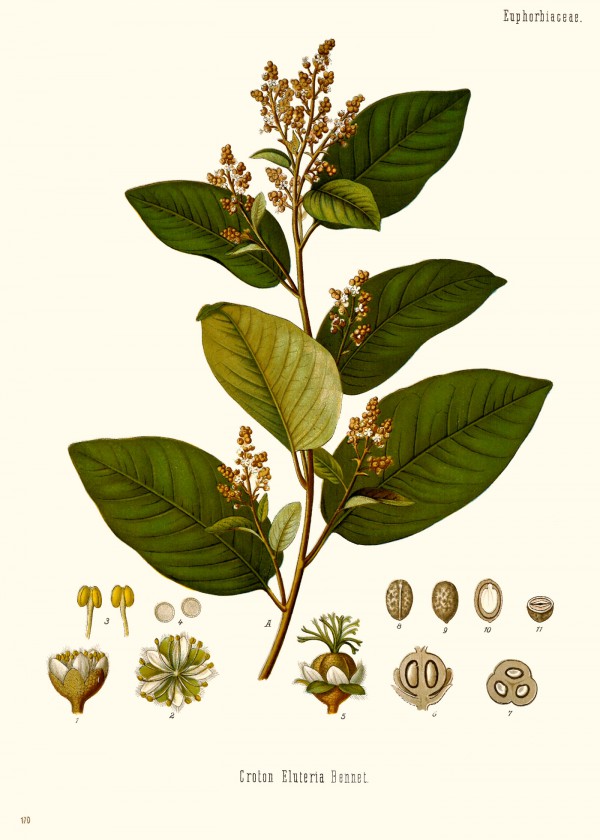Croton elutheria (L.) W.Wright - syn. Clutia eluteria L. - Euphorbiaceae - seaside balsam, cascarilla, Kaskarillabaum
Evergreen shrub or small tree, native to the Caribbean; leaves alternate, ovate-lanceolate; flowers fragrant, small, petals white.
Cascarilla bark (extract) is used as a component of aromatic bitters like Campari (an alcoholic liqueur, considered an apéritif, characterised by its dark red colour).
„The sesquiterpene fraction of commercial cascarilla oil (steam distilled from the dried bark of Croton eluteria) was separated by fractional distillation and repeated flash chromatography… The major constituent was identified as cascarilladiene (eudesma-5,7-diene) and was 6% of the total oil. Derivatives of this diene were also identified as the monoepoxide (5,6-epoxy-eudesm-7-ene), cascarilladienone (eudesma-4,6-dien-8-one), cascarilla furan and cascarilla lactone. Other constituents of interest were 1,11-oxidocalamenene, torilenol, β-dictyopterol, dihydro-ar-bisabolol and β-cedren-10-ol.“
[Analysis of the sesquiterpene fraction of cascarilla oil. Weyerstahl, P., Marschall-Weyerstahl, H., Manteuffel, E., Proceedings of the 11th international congress of essential oils, fragrances and flavours. (1989), Editors Bhattacharyya, S. C., Sen, N., Sethi, K. L., New Delhi, India, Vol.5, 1990, 43-48]
Main components isolated from commercial cascarilla oil by LC and GC were p-cymene (25%), geranylacetone (18%), cascarilladiene (11%), cascarilladienone (10%), linalool (11%), α-pinene (6%), α-thujene (6%), β-eudesmol (6%), cuparophenol (4%) and a clerodane diterpene, (decahydro-7-hydroxy-1,2,4a,5-tetramethyl-1-naphthyl)methyl-3-furanylketon (9%).
[The constituents of Cascarilla oil (Croton eluteria Bennett). Hagedorn, Myrna L., and Sharon M. Brown., Flavour and fragrance journal, Vol.6(3), 1991, 193-204]
„Three new diterpenoids belonging to the clerodane and halimane structural types have been isolated from the bark of Croton eluteria Bennet, commonly known as cascarilla. Their structures have been fully characterized by spectroscopic means. Cascarilla extract and its major component, cascarillin, were found to significantly increase histamine-induced gastric acid secretion in the mouse stomach. These preliminary results provide the first rationale for the use of cascarilla in bitter preparations aimed at improving digestion.“
[Minor diterpenoids from cascarilla (Croton eluteria Bennet) and evaluation of the cascarilla extract and cascarillin effects on gastric acid secretion. Appendino, G., Borrelli, F., Capasso, R., Campagnuolo, C., Fattorusso, E., Petrucci, F., & Taglialatela-Scafati, O., Journal of agricultural and food chemistry, Vol.51(24), 2003, 6970-6974]

Croton eluteria, Köhler, F.E., Medizinal Pflanzen, vol.2 t.170 (1890)
http://botanicalillustrations.org/species.php?id_species=291686